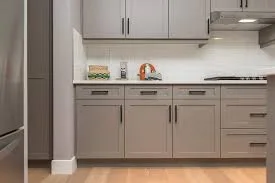Cabinet pulls make it easy to open drawers and doors while also adding to the look of your kitchen, bathroom, or storage cabinets. Over time, they can loosen, shift out of place, or even break, making cabinets harder to use and affecting their appearance.
The good news is that you can fix cabinet pulls with a few basic tools and simple steps. This guide will walk you through common problems and how to fix them one step at a time.
Common Problems with Cabinet Pulls
Before fixing a cabinet pull, it’s essential to identify the problem. Some common issues include:
- Loose Cabinet Pulls – The screws holding the pull have loosened over time.
- Stripped Screw Holes – The screw hole has become too big, making it difficult to secure the pull.
- Broken or Damaged Pulls – The pull is cracked, bent, or broken.
- Misaligned Pulls – The pull is incorrectly positioned, affecting the cabinet’s appearance.
- Missing Screws – One or both screws have fallen out, making the pull unstable.
Each problem has a simple fix, which we will explain below.
Tools and Materials You Will Need to Fix Cabinet Pulls
Gather the necessary tools before you begin:
- A screwdriver
- A drill (if you need to create new holes)
- Screws (matching size and length for your pulls)
- Wood filler or toothpicks (for repairing screw holes)
- Sandpaper (to smooth wood filler if needed)
- A level or ruler (for proper alignment)
- Wood glue (for added grip)
- A cabinet hardware template (optional but helpful)
Step-by-Step Guide to Fixing Cabinet Pulls
You can easily fix your cabinet pulls in 5 easy steps. Let’s check these out in detail below.
Step 1: Tighten Loose Cabinet Pulls
If your cabinet pull is loose but not damaged, tightening the screws is the first step.
- Hold the pull in place with one hand.
- Use a screwdriver to tighten the screws on the inside of the cabinet.
- If the screws keep turning without tightening, the screw hole may be stripped. If you are in this situation, just move to the next step.
Step 2: Fix Stripped Screw Holes
If the screw hole is too large, the screws won’t hold properly. Here’s how to fix it:
- Using Toothpicks: First of all, insert a few toothpicks into the hole. Then, apply a drop of wood glue to hold them in place. Let the glue dry for a few minutes. Remove any excess toothpick and screw the pull back in.
- Using Wood Filler: Apply wood filler into the hole. Leave it until it’s fully dry. Then sand it if you think it’s needed. Drill a new hole and reattach the pull.
Both of these methods will help secure the screws properly.
Step 3: Replace Broken Cabinet Pulls
If your pull is damaged, you must replace it with a new one.
- Remove the Old Pull – Unscrew and take off the broken pull.
- Choose a New Pull – Make sure it matches the existing hole spacing so you don’t have to drill new holes.
- Attach the New Pull – Align the new pull and secure it using screws.
- Tighten and Test – Ensure it is firmly attached and does not wobble.
If the new pull requires different hole spacing, you must drill new holes and patch the old ones using wood filler.
Step 4: Fix Misaligned Cabinet Pulls
If a pull is not aligned correctly, it can look odd and affect the cabinet’s function. Here’s how to fix it:
- Measure and Mark – Use a level or ruler to determine the correct placement.
- Loosen and Adjust – Slightly loosen the screws, adjust the pull, and retighten.
- Drill New Holes (If Needed) – If the misalignment is severe, fill the old holes, sand them smooth, and drill new ones in the correct position.
- Attach and Check – Secure the pull and check the alignment before fully tightening.
Step 5: Replace Missing Screws
If a screw is missing, find a replacement of the same size and type. If the original screws are stripped or too short, replace them with slightly longer ones for a better hold.
Preventing Cabinet Pulls Future Problems
To keep your cabinet pulls in good shape, follow these simple tips:
- Check and Tighten Regularly – Every few months, check your pulls and tighten any loose screws.
- Use the Right Screws – Avoid using screws that are too short or too long, as they can weaken the hold.
- Don’t Over-Tighten – Over-tightening can damage the cabinet surface and weaken the pullover time.
- Choose Quality Hardware – Invest in durable pulls and screws to prevent frequent repairs.
- Install Properly – Always measure and align pulls before attaching them.
Common Mistakes to Avoid While Fixing Cabinet Pulls
Fixing cabinet pulls may seem simple, but small errors can lead to misalignment, weak attachments, or even damage to the cabinet. Being aware of common mistakes can help you complete the task correctly and avoid unnecessary repairs later.
- Using screws that are too small can cause the pull to come loose.
- Drilling holes without measuring first can lead to misalignment.
- Ignoring loose pulls can result in further damage over time.
- Forcing screws into stripped holes instead of repairing them can weaken the hold.
- Skipping the alignment check can make the pulls look uneven.
- Over-tightening screws can damage the pull or crack the cabinet surface.
- Using screws that don’t match the pull’s size or thread can make them unstable.
- Not checking for obstacles inside the cabinet before drilling can cause installation issues.
- Skipping a test fit before securing the pull can lead to placement errors.
Final Thoughts
Fixing cabinet pulls is a simple task that anyone can do with essential tools. Whether the pull is loose, misaligned, broken, or missing screws, following the right steps will help restore it.
By tightening screws, repairing holes, replacing damaged pulls, and ensuring proper alignment, your cabinets will function properly and look neat.
Taking care of minor repairs early can save time and prevent bigger problems in the future. So, the next time you notice a loose or broken cabinet pull, grab your screwdriver and fix it in just a few minutes!

